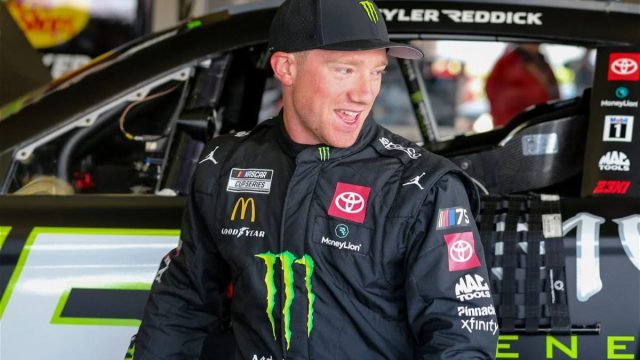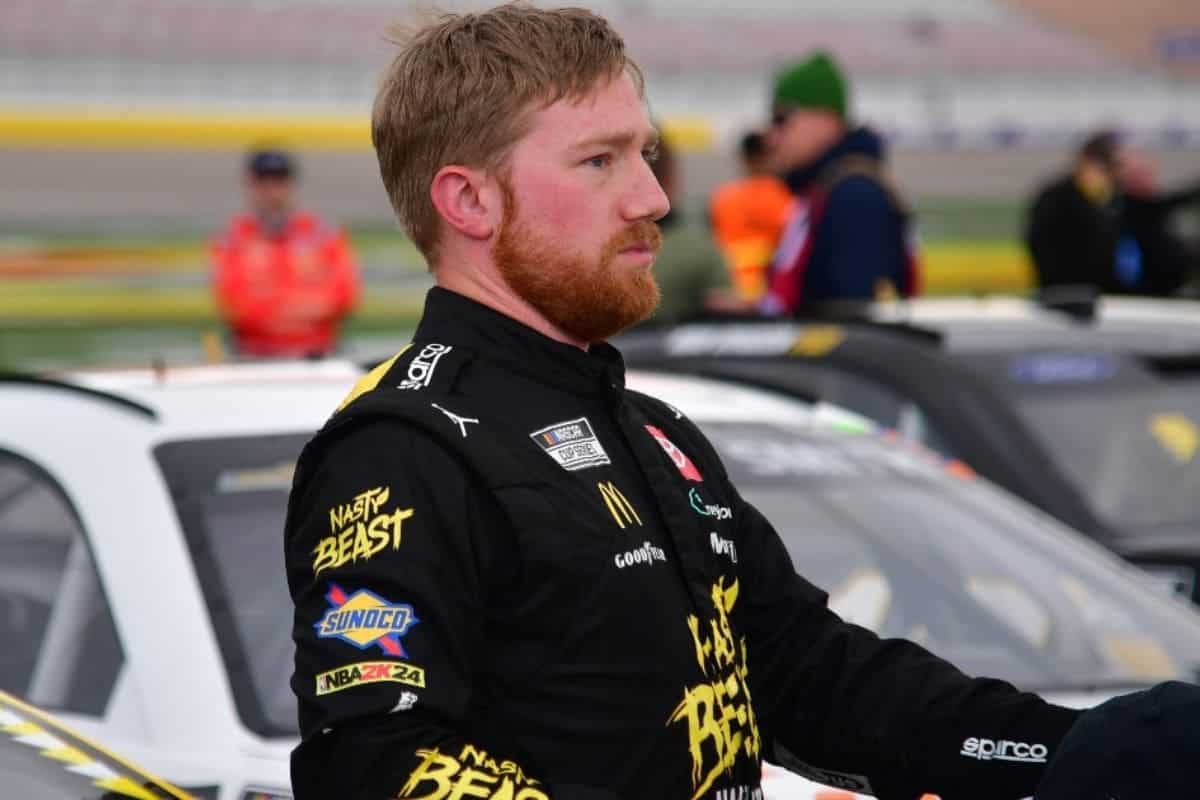Tyler Reddick Struggles With Goodyear’s New Tires: Tyler Reddick‘s commendable performance at New Hampshire Motor Speedway contrasted with his subsequent struggles during Goodyear’s wet weather tire test at Watkins Glen International. The introduction of Goodyear’s new tires, designed to improve performance under adverse conditions, presented significant adaptation challenges for Reddick. Compounded by the unpredictable weather, he experienced multiple spin-outs, showing the complexities of mastering these tires. This scenario raises pertinent questions about the implications for Reddick’s readiness for the impending NASCAR Cup Series playoffs, particularly in adapting to rapid technological changes under pressure.
Key Highlights
- Tyler Reddick spun out twice during the Goodyear tire test at Watkins Glen due to wet conditions.
- The unpredictable weather at Watkins Glen hindered Reddick’s ability to adapt to Goodyear’s new tire compounds.
- Wet weather tires were not tested at Watkins Glen, depriving Reddick of valuable adaptation data.
- Reddick faced a steep learning curve with wet weather tires, highlighted by his performance challenges at Watkins Glen.
- The early termination of the Goodyear tire test limited Reddick’s opportunity to refine his performance on new tires.
Introduction to Wet Weather Tires and Tyler Reddick’s Struggles
In NASCAR, the introduction of wet weather tires has been a game-changer, yet Tyler Reddick’s recent performances highlight the complexities and challenges these conditions present for even the most skilled drivers.
The deployment of wet weather tires at New Hampshire Motor Speedway was met with enthusiasm from fans and most drivers, signaling NASCAR’s commitment to maintaining race continuity despite adverse weather conditions. However, Reddick’s experience shows the difficulties inherent in adapting to these tires.
Despite his aptitude and readiness, Reddick faced significant hurdles. At NHMS, he was on the verge of securing his next win of the season. Unfortunately, the race resumed after a two-hour weather delay, thrusting Reddick into a scenario where mastery over the new tires was critical. The wet conditions, combined with the unfamiliarity of the wet weather tires, proved challenging, and Reddick’s struggle was evident.
The complexities did not end at NHMS. During a subsequent tire test at Watkins Glen International, Reddick once again grappled with the intricacies of handling the wet weather tires. This historic New York road course presented its own set of challenges, amplifying the difficulty faced by drivers in wet conditions. Reddick’s performance at Watkins Glen highlighted the steep learning curve associated with these tires, reinforcing that even seasoned drivers must reassess their skills to adapt to the changing technologies in NASCAR.
Premature End to Goodyear Tire Test
The Goodyear tire test at Watkins Glen International was prematurely concluded due to unpredictable weather conditions, showing the inherent difficulties of optimizing tire performance for diverse track environments. The 2.428-mile road course presented a challenging setting for evaluating six different tire compounds aimed at enhancing NASCAR’s road course package.
Participants included Cup Series drivers Daniel Suarez, Joey Logano, and Tyler Reddick, along with Xfinity drivers Jesse Love, Ryan Sieg, and John Hunter Nemechek. Despite the presence of seasoned and skilled drivers, the absence of wet-weather tires during the test was a significant oversight. This decision exposed the participants to heightened risks, as evidenced by multiple incidents on the track.
“Tyler Reddick said he spun out twice during testing today but did not damage his car. Daniel Suarez said he spun out once and Jesse Love ended up in the tire barrier in his Xfinity car.” – (Nathan Solomon)
Tyler Reddick reported spinning out twice, while Daniel Suarez experienced a single spin. Jesse Love encountered the most severe consequence, ending up in the tire barrier with his Xfinity car. These incidents highlighted the risky balance between tire performance and safety, particularly under variable weather conditions.
The early termination of the test deprived Goodyear and NASCAR of valuable data crucial for fine-tuning tire compounds. The iterative process of tire development relies heavily on extensive testing under different conditions to guarantee top-notch performance and safety. The premature end not only cut short the assessment of the new compounds but also left unresolved questions regarding their effectiveness on wet surfaces.
Impact of Rain on Tire Testing
Rain heavily disrupted the tire testing process at Watkins Glen International, showing the challenges of evaluating tire performance under unpredictable weather conditions. The testing, intended to refine NASCAR’s road course package, was severely impacted by a shift from drizzle to a downpour. This abrupt weather change forced the session to wrap up an hour earlier than planned, leaving critical gaps in the data collection process.
“The Goodyear tire test at Watkins Glen wrapped up an hour early today due to rain.” – (Nathan Solomon)
The objective of the test was to assess six different tire compounds, including one previously used at Sonoma Raceway, with drivers expected to complete seven laps on each compound on the initial day. However, the rain-induced interruptions ruined this systematic approach, complicating the comparison of tire performance. Such inconsistencies in testing conditions can obscure the variations of tire behavior, impeding the ability to draw definitive conclusions.
Tyler Reddick’s experience represented the difficulties faced. Struggling for grip, he spun out twice, highlighting the adverse impact of wet conditions on tire evaluation. The rain not only compromised the integrity of the test but also increased the risk of erroneous assessments of tire compounds. When drivers cannot consistently push the tires to their limits due to weather constraints, the feedback loop necessary for precise adjustments and improvements is disrupted.
Furthermore, the planned shift to 20-lap runs on the subsequent day depended on favorable weather, magnifying the dependency on stable conditions for exhaustive testing. The unpredictability of rain poses a significant setback, emphasizing the need for contingency strategies in tire testing protocols.
Decision Not to Test Wet Weather Tires
Surprisingly, the decision not to test the wet weather tires during the disrupted session at Watkins Glen International raises critical questions about the strategic foresight of the teams and NASCAR officials. Despite the evident weather conditions that led to an early termination of the session, teams refrained from utilizing the wet weather package, a decision that could have significant consequences as the playoffs approach.
From an analytical standpoint, the rationale behind this decision seems flawed. Rain was a known variable at Watkins Glen, yet the teams and officials did not capitalize on the opportunity to gather important data. This oversight is even more perplexing given the success of wet weather tires in previous races, such as at New Hampshire Motor Speedway. The wet weather tires had proven to be a game-changer, providing improved grip and safety under adverse conditions.
Furthermore, with all three Cup Series drivers competing in the playoffs, the value of testing these tires cannot be overstated. Watkins Glen is the venue for the next playoff race, making it an ideal setting for trialing wet weather strategies. The failure to do so represents a missed opportunity to refine performance and strategy under playoff conditions.
Tyler Reddick’s Disappointment at New Hampshire
Tyler Reddick’s disappointment at New Hampshire Motor Speedway was noticeable, as he faced significant challenges despite initially inheriting the lead and fighting valiantly against tire disadvantages. After taking the lead at the end of the second stage, Reddick skillfully maintained his position through multiple restarts, fending off fierce competition from Ryan Blaney, Kyle Larson, and Denny Hamlin. His determination was evident, even as he contended with Goodyear’s new tire setup, which had left many drivers struggling to find the right balance.
The race’s trajectory shifted dramatically when rain interrupted proceedings, leading to a prolonged two-hour and 14-minute delay. As the race resumed under damp conditions with wet weather tires, Reddick’s fortunes took a downturn. On lap 242, Christopher Bell managed to overtake him, ultimately relegating Reddick to a sixth-place finish. This outcome was particularly bitter for Reddick, who had led for 53 laps and appeared ready to secure his runner-up win of the season.
In a post-race interview, Reddick reflected on the challenges he faced, acknowledging that while the final result was disappointing, it was still a respectable finish given the circumstances.
“Yeah, it’s a bummer, but overall, a good finish for our Toyota Camry. I don’t know if we were going to crack the top ten straight up today for whatever reason, so we’ll take the opportunity. It didn’t shake it out, obviously, but we still got a sixth place out of it and I think that is better than we were gonna run, had it stayed dry.” – (Tyler Reddick)
As the NASCAR Cup Series heads towards Watkins Glen International, Reddick remains fifth in the drivers’ standings. His focus now shifts to the upcoming playoff races, where he hopes for more favorable conditions and a return to the winner’s circle.
News in Brief: Tyler Reddick Struggles With Goodyear’s New Tires
The challenges faced by Tyler Reddick with Goodyear’s new tires during the wet weather test at Watkins Glen International show the complexities of adapting to new tire technology under unpredictable weather conditions.
Despite multiple spin-outs, Reddick’s resilience and determination remain evident as he navigates the learning curve.
These experiences emphasize the importance of continuous adaptation and preparation for upcoming playoff races in the NASCAR Cup Series, highlighting the intricate balance between driver skill and tire performance.
ALSO READ: Tyler Reddick’s Hamburglar Firesuit Steals the Spotlight



